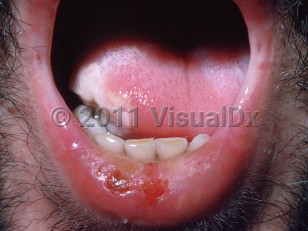Drug-induced oral ulcer - Oral Mucosal Lesion
Alerts and Notices
Important News & Links
Synopsis

Pathogenetic mechanisms include focal irritation due to low pH (aspirin), allergic hypersensitivity (gold, NSAIDs), or cytotoxicity (antimetabolites).
Medications with strong evidence for antimetabolic injury of oral mucosal epithelium include chemotherapeutic agents such as 5-fluorouracil, 6-mercaptopurine, methotrexate, bleomycin, doxorubicin, daunorubicin, docetaxel, topotecan, and actinomycin-D. More recently, everolimus, an mTOR inhibitor, has been recognized to be a cause of stomatitis and oral ulceration.
Immune-mediated mechanisms, resulting in an ulcerative lichenoid reaction, have been described for a wide range of systemic medications, including captopril, carbamazepine, methyldopa, naproxen, indomethacin, zomepirac, lithium, and prochlorperazine, although this is an ever-expanding list. Similar lesions can be induced locally by mercury salts associated with large deteriorating amalgam (silver) dental fillings that contact the buccal or lingual mucosa.
Drugs such as penicillamine and captopril have been implicated in the causation of pemphigus vulgaris, which usually has a mucosal-predominant presentation.
Stevens-Johnson syndrome (SJS) / toxic epidermal necrolysis (TEN) frequently has oral mucosal findings including erosions, ulceration, and hemorrhagic crusting of the lips. SJS / TEN is considered a potentially life-threatening emergency.
Related topics: chemotherapy-induced mucositis, drug-induced oral mucositis, oral lichen planus
Codes
T50.995A – Adverse effect of other drugs, medicaments and biological substances, initial encounter
SNOMEDCT:
403665005 – Drug-induced oral ulceration
Look For
Subscription Required
Diagnostic Pearls
Subscription Required
Differential Diagnosis & Pitfalls

Subscription Required
Best Tests
Subscription Required
Management Pearls
Subscription Required
Therapy
Subscription Required
Drug Reaction Data
Subscription Required
References
Subscription Required

